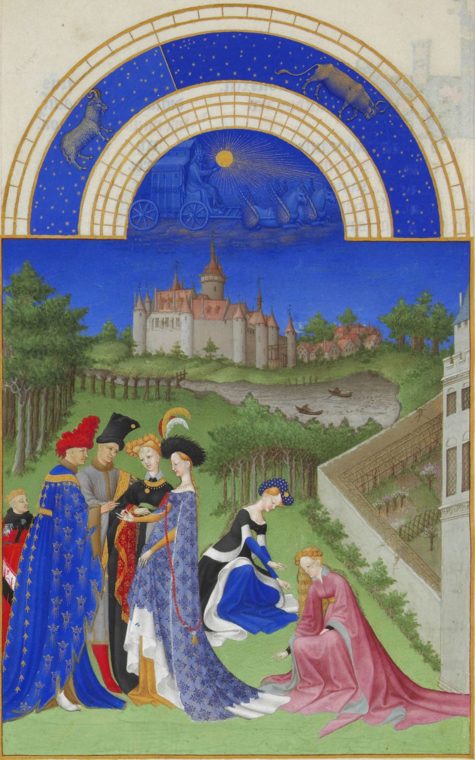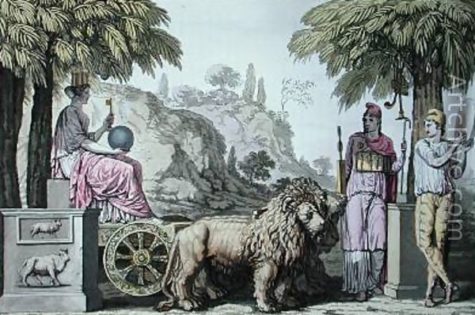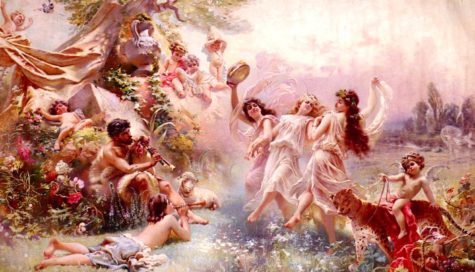Daily Archives: April 2, 2017
April gets its name from the goddess Aprilis, who is the Romans’ version of Aphrodite. Her name means “to open,” which is exactly what Aprilis does… she opens the path to playfulness and the way to personal enrichment.
We all know the rhyme “April showers bring May flowers.” So consider what energies you want Aprilis to sprinkle on you this month for personal flowering. Overall, any magical efforts aimed toward growth, love, pleasure, improvements, and developing one’s inner child will benefit from working this month.
Because the Christian holiday of Easter sometimes falls in this month, the Anglo-Saxons and Franks called it Easter Month; of course, the word Easter comes originally from the name of the Pagan goddess Eostre, deity of Spring, fertiilty, and new life. The Romans called this month Aprilis, a time of unfolding leaves and flowers.
April was the second month of the Roman calendar, before January and February were added by King Numa Pompilius about 700 BC. It became the fourth month of the calendar year (the year when twelve months are displayed in order) during the time of the decemvirs about 450 BC, when it also was given 29 days April is commonly associated with the season of spring in the Northern hemisphere and autumn in the Southern hemisphere.
Correspondences for April:
- Nature Spirits: Plant faeries
- Herbs: Basil, chives, dragons blood, geranium, thistle
- Colors: Crimson red, gold
- Flowers: Daisy, sweetpea
- Scents: Pine, bay, bergamot, patchouli
- Stones: Ruby, garnet, sard
- Trees: Pine, bay, hazel
- Animals: Bear, wolf
- Birds: Hawk, magpie
- Deities: Kali, Hathor, Anahita, Ceres, Ishtar, Venus, Bast
- Birth stone: Diamond
- Birth flower: Daisy or sweet pea
- Zodiac Signs: Aries (until April 19) and Taurus (April 20 onwards).
Power Flow:
Energy into creating and producing; return balance to the nerves; change; self confidence; self reliance; take advantage of opportunities; work on temper and emotional flare-ups and selfishness.
April Festivities:
The Megalesia of Cybele, who was also known as Magna Mater (Great Mother) in both Phyrgia and Rome, celebrated the arrival of this goddess in Rome. In 204 BCE, Rome was in the midst of a great war with Hannibal. Things were going very badly for the Roman legions. Finally, the Romans sent a delegation to the Oracle at Delphi for an interpretation of their sacred Sibylline Books. This passage said that foreing invaders could only be driven away when the Mother of Mount Ida was transferred from Pessinus to Rome.
The oracle sent the delegation to the king of Pergamum in Asia Minor, where they were told that a black meteroite embodying the spirit of Cybele was. Pine trees from Mt. Ida, sacred to the goddess, were made into a ship, and the stone was transported from one sanctuary to another until it reached Rome. In about a year, Hannibal left Italy forever.
The Japanese Flower Festival has now become a celebration of Buddha’s birth. In the older celebration, however, the people gathered wildflowers for the family shrine. Those in the Shinto faith placed wooden markers on the graves and said prayers.
The Roman festival of Cerealia celebrated the return of Proserpina to the Earth goddess Ceres. Our word “cereal” comes from the name Ceres. It was the time of planting grain. Ceres was the Roman equivalent to the Greek goddess Demeter.The festival of Cerealia was held for seven days from mid-to-late April, but exact dates are uncertain.
Feriae Latinae was also held in April, with the date varying. Other ancient Roman observances include Veneralia, Fordicidia, Parilia, Vinalia Urbana, Robigalia, and Serapia.
The Egyptians called their land Khemennu, or Land of the Moon. Plutarch wrote that they believed the Moon to be the Mother of the Universe. Although the goddess Bast was primarily considered to be a deity of the gentle Sun, she was also connected with the Moon.
Floralia was held April 27 during the Republican era, or April 28 on the Julian calendar, and lasted until May 3. However, these dates do not correspond to the modern Gregorian calendar. The Floralia is still celebrated in many Central and Eastern European countries. It is a time to honor the goddess of flowers. People dress in gaily decorated costumes and wear flowers in their hair. Secretly delivering baskets of flowers on May Day is a remnant of this old festival.
During this month was also the Incan Ayrihua or Camay Inca Raymi, the Festival of the Inca.
April Weather Lore
It is said that if early April is foggy,
rain in June will make lanes boggy.
April weather:
rain and sunshine, both together.
April showers bring May flowers.
A dry April
Not the farmer’s will.
April wet
Is what he would get.
“If it rains on Easter Sunday,
it will rain on the next seven Sundays.”
More April Lore:
St George’s day is the twenty-third of the month; and St Mark’s Eve, with its superstition that the ghosts of those who are doomed to die within the year will be seen to pass into the church, falls on the twenty-fourth.
In China the symbolic ploughing of the earth by the emperor and princes of the blood took place in their third month, which frequently corresponds to April. In Finnish April is huhtikuu, meaning slash-and-burn moon, when gymnosperms for beat and burn clearing of farmland were felled.
In Slovene, the most established traditional name is mali traven, meaning the month when plants start growing.
The month Aprilis had 30 days; Numa Pompilius made it 29 days long; finally Julius Caesar’s calendar reform made it again 30 days long, which was not changed in the calendar revision of Augustus Caesar in 8 BC.
The Lyrids meteor shower appears on April 16-April 26 each year, with the peak generally occurring on April 22. Eta Aquariids meteor shower also appears in April. It is visible from about April 21 to about May 20 each year with peak activity on or around May 6. The Pi Puppids appear on April 23, but only in years around the parent comet’s perihelion date. The Virginids also shower at various dates in April.
The theme for April
The theme for April is momentum. When something has momentum it takes more of an effort to change its course, and less of an effort to move it in the direction it is already going. This is a tricky month as momentum will take hold in whatever direction you happen to be putting your focus and energy.
For example, if you are in a bad mood, that mood is in danger of gathering momentum. If you are focused on a creative project of your choosing, it will also gather momentum. It is very important that you are focused on the things you want in your life at this time for they are the ones that will gather momentum.
This is a highly creative and productive time. The challenge will be to stay directed and to have the discipline to move yourself out of situations and away from negativity that you would rather not be gathering momentum around. This will take discernment, the use of good boundaries and a commitment to some truth telling about what serves you and what does not.
If you find yourself in a downward spiral where everything seems to be falling apart in a big way, you may need to look at the truth of allowing something you have been holding onto to dissolve and leave your life. You may finally have the momentum to move yourself out of a situation that is not healthy or serving. On the other hand, a creative project that is aligned with spirit may have just been waiting for such a time to take off.
From:
- Moon Magick
- Lena Stevens, The Power Path
- Various other sources
 The Cold Food Festival or Hanshi Festival is a traditional Chinese holiday celebrated for three consecutive days starting the day before the Qingming Festival in the Chinese Calendar, which falls on the 105th day after dongzhi (April 5 by the Gregorian calendar, except in leap years). It is celebrated in China as well as the nearby nations of Korea and Vietnam. At this time of year, the sky becomes clearer and buds sprout in the field. Farmers sow various seeds and supply water to their rice paddies.
The Cold Food Festival or Hanshi Festival is a traditional Chinese holiday celebrated for three consecutive days starting the day before the Qingming Festival in the Chinese Calendar, which falls on the 105th day after dongzhi (April 5 by the Gregorian calendar, except in leap years). It is celebrated in China as well as the nearby nations of Korea and Vietnam. At this time of year, the sky becomes clearer and buds sprout in the field. Farmers sow various seeds and supply water to their rice paddies.
The Cold Food Festival started from the ancient tradition of setting fire by rubbing wood pieces together and the tradition of lighting new fires. Due to the change of seasons and the change in the type of wood available, the ancient practice was to change the type of fire-starter-wood used from season to season. Fire is lighted anew upon the start of each season. Before the new fire is officially started no one is allowed to light a fire. This was an important event during that time.
The traditionally practiced activities during the Cold Food Festival includes the visitation of ancestral tombs, cock-fighting, playing on swings, beating out blankets (to freshen them), tug-of-war, etc. The practice of visiting ancestral tombs is especially ancient.
In China ancestral worship used to be practiced during the time of the Cold Food Festival. It was later moved to coincide with the Qingming Festival. However in Korea, where the festival is called Hansik , the tradition of ancestral worship during the Cold Food Festival still remains.
In the modern version of Hansik, people welcome the warm weather thawing the frozen lands. On this day, rites to worship ancestors are observed early in the morning, and the family visits their ancestors’ tombs to tidy up.
Falling on the 105th day after the winter solstice (April 5 by the Gregorian calendar, except in leap years). At this time of year, the sky becomes clearer and buds sprout in the field. Farmers sow various seeds and supply water to their rice paddies. The custom of eating cold food on this day is believed to originate from a Chinese legend (see Tomb Sweeping Day), but recently this custom has disappeared.
Since this day coincides with Arbor Day, public cemeteries are crowded with visitors planting trees around the tombs of their ancestors.
In Vietnam, where it is called Tết Hàn Thực, the Cold Food Festival is celebrated by Vietnamese people in the northern part of the country on the third day of the third lunar month, but only marginally. People cook glutinous rice balls (see recipe and more info) called bánh trôi on that day but the holiday’s origins are largely forgotten, and the fire taboo is also largely ignored.
Source: Wikipedia
The Megalisia was a Phrygian festival in honor of Cybele, the Magna Mater. This was a festival with games celebrated at Rome in the month of April and in honor of the great mother of the gods. Following the advice of the Sibylline oracle on how to end the Punic wars, the meteorite which represented Cybele was brought from Phrygia to Rome in 204 BCE where it was installed in the Temple of victory on April 4th. The day of its arrival was solemnized with a magnificent procession, lectisternia, and games, and great numbers of people carried presents to the goddess at the Capitol.
The following harvest was great and the war ended the next year.
The regular celebration of the Megalesia, however, did not begin until about a dozen years later, when the temple which had been vowed and ordered to be built in 203 B.C., was completed and dedicated by M. Iunius Brutus.
The Romans began the celebrations with a parade, in which an image of the Goddess, Cybele, was carried through the streets in a chariot drawn by lions, her animals. The castrated priests who served her danced alongside, playing timbrels and cymbals and gashing themselves. Lucretius says “with bronze and silver they strew all the paths of her journey … and snow rose-blossoms over her.”Rome, commemorating the arrival of the goddess to her Roman Temple.”
The festival lasted for six days, beginning on the 4th of April. The season of this festival, like that of the whole month in which it took place, was full of general rejoicings and feasting. It was customary for the wealthy Romans on this occasion to invite one another mutually to their repasts, and the extravagant habits and the good living during these festive days were probably carried to a very high degree. For that reason, a senatusconsultum was issued in 161 B. C., prescribing that no one should go beyond a certain extent of expenditure.
The games which were held at the Megalesia were purely scenic, and not circenses. They were at first held on the Palatine in front of the temple of the goddess, but afterwards also in the theaters.
The first ludi scenici at Rome were, according to Valerius Antias, introduced at the Megalesia, either in 193 or 191 b.c. The day which was especially set apart for the performance of scenic plays was the third of the festival.
Slaves were not permitted to be present at the games, and the magistrates appeared dressed in a purple toga and praetexta, whence the proverb, purpura Megalensis. The games were under the superintendence of the Curule Aediles, and we know that four of the extant plays of Terence were performed at the Megalesia. Cicero, probably contrasting the games of the Megalesia with the more rude and barbarous games and exhibitions of the circus, calls them maxime casti, solemnes, religiosi.
Source: Nova Roma and Smith, Dictionary of Greek and Roman Antiquities
Note:
The book, 365 Goddess, describes this festival as a Roman Festival celebrating the accuracy of the Sibylline oracles, who predicted the way for the Roman victory in the Punic Wars. Her suggestions for celebrating this ancient festival is as follows:
- Themes: Divination, Protection, Victory, Children, Birth, Communication.
- Symbols: The written word, Divination tools, Fertility symbols.
- Rulers: The Carmenae.
The Carmenae is a group of goddesses who correspond to the Muses of Greek tradition; they know our past, see what’s in store in the future, foretell children’s fates, and teach us the effective use of “letters” (the alphabet), the arts, and how to tell fortunes. They also oversee midwives.
Romans traditionally honored the goddesses today with music and song, so put on some magical tunes! The Carmenae will saturate the music and uplift your spirit.
Ask the Carmenae to help you write personalized invocations or spells today. Put pen to pad and let these goddesses inspire sacred words suited to your path and needs. Keep these in a magick journal for future use.
The Roman oracles often drew lots to determine a querent’s answer. If you have a question weighing heavily on your heart today, follow this custom and take out some variegated beans. Hold them. Concentrate on the question, then pick out one bean. A black one means “no”; white means “yes.” Red means that anger is driving action, brown means things are muddled, and green indicates growth potential. If you don’t have the beans, colored buttons or beads are a suitable alternative.
Qingming Festival (also known as Pure Brightness Festival or Tomb-sweeping Day), falls on either April 4th or 5th of the Gregorian calendar. The Chinese respect for filial piety and careful attention to funeral rites is visibly manifested in the custom of ancestor worship.
Since ancient times, a day has been designated for sweeping the tomb and honoring one’s ancestors. Though different in each family, these rites are usually performed on the first few days prior to or following Ching Ming, one of the traditional solar divisions falling in early April, when the frost retreats and spring returns bringing renewal to all living things.
When visiting the tomb, people usually bring the dead person’s favourite food and wine, and paper resembling money . This is in the hope that the deceased are not lacking food and money. After burning the paper money, tidying up the tomb, and putting willow branches around the gates and doors of the tomb to ward off evil spirits, people will eat the food and fruit before returning to their homes.
The folklore behind the story is as follows:
It is said that the Qingming Festival was originally held to commemorate a loyal man living in the Spring and Autumn Period (770 – 476 BC), named Jie Zitui. Jie cut a piece of meat from his own leg in order to save his hungry lord who was forced to go into exile when the crown was in jeopardy. The lord came back to his position nineteen years later, and forgot Jie Zitui but later felt ashamed and decided to reward him. However, Jie had blocked himself up in a mountain with his mother. In order to find Jie, the lord ordered that the mountain should be set on fire. Later Jie was found dead with his mother. In order to commemorate Jie, the lord ordered that the day Jie died was Hanshi (Cold Food) Festival – the day that only cold food could be eaten.
The second year, when the lord went to the mountain to sacrifice to Jie, he found willows revived, so he gave instructions that the day after Hanshi Festival was to be Qingming Festival. Later, the two festivals were combined as one.
Traditional Customs
Qingming Festival is a time of many different activities, among which the main ones are tomb sweeping, taking a spring outing, and flying kites. Some other lost customs like wearing willow branches on the head and riding on swings have added infinite joy in past days. The festival is a combination of sadness and happiness.
Cleaning the tomb and paying respect to the dead person with offerings are the two important parts of remembering the past relatives. Weeds around the tomb are cleared away and fresh soil is added to show care of the dead.
Today, with cremation taking over from burying, the custom has been extremely simplified in cities. Only flowers are presented to the dead relatives and revolutionary martyrs. No matter how respect is shown, good prayers for the deceased are expressed.
All in all, the Qingming Festival is an occasion of unique characteristics, integrating sorrowful tears to the dead with the continuous laughter from the spring outing.
From: Travel China Guide











